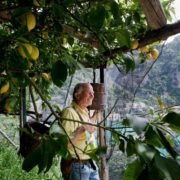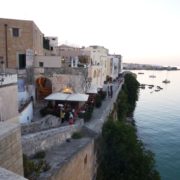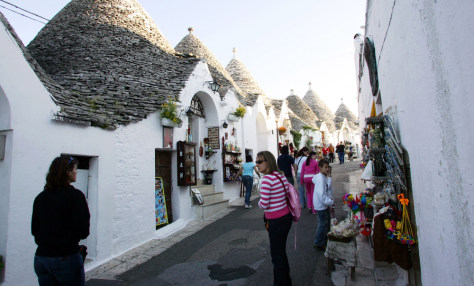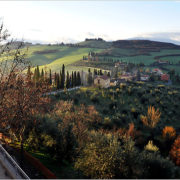IT was a cold, foggy morning in Tuscany, and La Foce, a 15th-century villa that sits on 2,000 acres of rolling fields overlooking the storied Montepulciano vineyards, was eerily quiet.
I walked the stone pathways in the manicured garden. Around me, cypress trees creaked, ripe persimmons swayed soundlessly from bare branches and a scattering of white flowers clung to a stone wall for warmth. Far below, a miniature Fiat truck made its way up the hillside, chugging along the empty, winding road.
The last time I was in Tuscany, it was July. Fields were ablaze in that golden yellow you see on postcards, bikers in neon Lycra were swarming the roads, and tour buses jammed the medieval piazzas. And I’d had the brilliant idea of inviting 120 non-Italian-speaking friends to the tiny village of Pienza for my wedding. “Beautiful, hot and full of Americans” was how one ungracious guest had put it.
But now, the temperature had dropped to 40 degrees and the color palette had shifted to the shockingly bright green that appears in these hills only in the winter and early spring. Steely gray fog rolled slowly across the valley, and a blanket of silence suggested a landscape that had gone into hibernation.
Forget the magazine covers that promise “The Undiscovered Tuscany!” “The Hidden Tuscany!” “The Secret Tuscany!” When a place has been attracting admirers for more than a thousand years, no square inch is undiscovered. The real Tuscany, as locals have been telling me over the years, is found in the dead of winter, when the crowds are thinner and the rooms, flights and restaurants are pleasantly cheaper.
That’s what brought me — along with my husband and our new baby — back to the Val d’Orcia in December. We came to visit friends who live here and to experience a Tuscany populated only by Tuscans.
Bordered to the north by the hills of Siena and to the south by the imposing arc of Monte Amiata, the valley is known for a few things: the cypress trees that line its winding roads (no calendar of Italy is complete without a picture of them), the creamy saltiness of its pecorino cheese, and Brunello di Montalcino, a king of Italian wines. Basically everything I care about in life.
The Val d’Orcia is also a Unesco World Heritage Site (take that, Chianti). “I love the Val d’Orcia in the winter — you get a much truer Tuscany,” said Benedetta Origo, who, along with her sister, Donata Origo, owns the La Foce estate, where their family used to live. Their mother, Iris Origo, wrote “War in Val d’Orcia: An Italian War Diary, 1943-1944” — the de facto textbook of the area.
“This time of year, the clay turns to mud,” Ms. Origo said. “I put on my boots and go for long walks along the quiet paths in the forest. It’s rather poetic. And you can always expect to see a family of wild boar.”
In fact, the wildlife is a big part of the charm of the area. “The landscape is lush and full of boar, hares and pheasants, whereas in the summer, you don’t see animals, and fields are plowed and brown.” This is John Voigtmann, an American expat who turned a crumbling stone barn into La Bandita, an eight-room boutique hotel that sits atop the most-photographed of those cypress-lined roads. With its sleek four-poster beds and infinity-edge pool, it is one of the rare modern-design hotels in the area. “This is the time of year you see real Tuscans sitting in a cafe, drinking a grappa,” Ms. Origo added. “Maybe people are a little friendlier. The Val d’Orcia comes back to its own life.”
In that spirit, we set out on a brisk Wednesday morning for the medieval town of Sant’Angelo in Colle for lunch. As we drove to the tiny hilltop village, it started to drizzle, then pour. Winter in Tuscany is damp and pleasantly cool, with temperatures dipping as low as 30 degrees, though it rarely snows in the valley. And the landscape turns to a vibrant shade of jungle-y emerald — the only place I know that gets more colorful in the winter.
The village — sand-colored stone palazzi and worn cobblestone paths, all drenched in mist and rain — sat like a slumbering animal on top of the hill. I tried to remember if I had been there before. After a dozen trips to the area, I still have trouble telling one beautiful medieval mountaintop village from the next.
There wasn’t a soul in sight. We parked our car on the road (there was no shortage of spaces) and dashed into Il Leccio, a restaurant and wine bar.
Il Leccio is a trattoria, meaning a casual, pasta kind of place, but the starched tablecloths, crystal wineglasses and armor mounted on the wall made me feel as if I should have been summoned to the table by a man in white gloves. The menu is full of Tuscan fare, but Il Leccio is best known for its wine cellar (4,000 bottles deep) and as the unofficial cantina of Tuscany’s legendary wine producers.
On any given winter day, you might sit next to the man who made the vintage on your table. Winemakers flock here to talk about the harvest, complain about rain and order a bottle — of their own, naturally. In fact, as we were digging into our spinach and ricotta ravioli in a butter and sage sauce, we noticed that Gianfranco Soldera, the superstar producer behind the cult Soldera Brunello, was seated across from us.
Inspired by all the talk of vintages and varietals, we decided to drop by a nearby winery after lunch, the Ciacci Piccolomini d’Aragona, a family-run vineyard that produces Tuscan mainstays: rosso, brunello and a supertuscan. In the summer, this would have been vacation suicide. The region’s top vineyards are often impossible to get into from June to September, clogged with busloads of tipsy tourists. But after a 15-minute drive down a deserted muddy track that trundled through the forest, we found ourselves walking alongside gargantuan oak casks, alone except for a young tour guide, Martina Frullanti, our footsteps echoing off the vaulted stone ceilings.
We had the whole place to ourselves. It was all very “Welcome to my own private Tuscan estate, please tie up your horse outside.” After Il Leccio, I could hardly try any more wine, but we bought two bottles of the estate’s 2003 brunello. “This is a big wine,” explained Ms. Frullanti. “It’s best in the winter.”
So goes a common refrain: the flavors of Tuscany actually taste better this time of year. First, Tuscan cuisine is winter fare: big red wines, lots of porcini mushrooms, black truffles, chestnuts, and hearty pastas with meat sauce. In addition, Tuscans eat what’s in season, and the best stuff ripens between October and March.
November has the olive harvest. Once they’re picked, the olives are pressed immediately, giving the oil a green, spicy flavor unique to those first few weeks. Pecorino cheese is creamier in the fall and winter, when the sheep eat grass, not hay (a local secret). Winter also coincides with hunting season, so even the cinghiale (wild boar) is fresh, not frozen as it is the rest of the year.
Winter, in other words, is eating season in Tuscany. To test this out, we visited Il Casale, a strange and almost fantastical farm near Pienza, run by perhaps the most eccentric family in the valley. To get there, we drove down a long dirt road overgrown with brush until we saw what looked like a typically lovely stone villa. But as soon as we stepped out of the car, we were greeted by shaggy dogs, peacock squawks and the unmistakable smell of farm. The source of the odor was an open barn, just behind the villa, humming with shuffling sheep.
Everything produced at Il Casale is organic; the animals roam freely around the grounds, and they create almost no waste (pigs eat the whey left over from the cheese). Even “our veterinarian is homeopathic,” said Ulisse Brandli, a charming if curmudgeonly Swiss expat who moved to Tuscany in 1991 with his wife, Sandra, and has since raised five sons and hundreds of animals.
Mr. Brandli speaks emphatically and at great, great length about the virtues of small farms. Once you see firsthand how the food is made, he said, “it will taste different to you.” As we were talking, half a dozen pigs, muddy and playful, came trotting up. These were the renowned cinta senese pigs, indigenous to Tuscany, named for the white belt around their bellies, and famously flavorful. Not that I could imagine eating one, once I saw how cute they were.
Before we left, we loaded up our car with honey, olive oil and a small wheel of Mr. Brandli’s freshest batch of pecorino. We sliced into the cheese later that day over a simple lunch of crusty bread, foggy green olive oil and a bottle of rosso di Montalcino. The cheese was decidedly creamier, akin to the difference between Greek yogurt and the nonfat kind.
Amazingly, there are things to do in Tuscany that don’t involve food or wine. The following morning, my husband and baby stayed behind at the hotel as I drove to Bagno Vignoni, a medieval village built on thermal waters from an aquifer and popular since the Roman empire. The town square is a giant pool fed by volcanically heated water bubbling from the depths, steaming in the winter air, and the village has its share of day spas that use the water. A hot bath isn’t so appealing during an August heat wave, but on a blustery day in December, it was perfect.
After paying 28 euros (about $37), I wrapped myself in a plush robe and walked up to the rooftop pools at the newly opened Le Terme Wellness & Spa. I settled in a lounge chair next to a few elderly Tuscan ladies with painted nails and weathered faces. Unversed in Tuscan spa etiquette, I followed their lead: when they helped themselves to hot lavender tea from the silver tray, I did, too. When they dunked in the steaming bath, I dunked. And when it came time for them to wrap themselves in their towels and start gossiping, I took out my book, but then closed my eyes and let the chatty voices lull me to sleep.
On another day, relaxed and recharged, it was time to visit Montepulciano, the medieval fortress town that was recently infiltrated by the cast and crew of “The Twilight Saga: New Moon.” For some, the town is synonymous with Tuscany, a nostalgic vision of wine shops that date back to the first Pope Benedict and old crinkly men playing bocce in 14th-century sandstone courtyards.
Of course, Montepulciano long ago became a tourist magnet. But on this heavy winter day, you could almost glimpse what the town was like before it became a cliché — schoolchildren running through piazzas, the smell of wood-burning fires, and a handful of those crinkly old men, their collars upturned, bracing against the chill.
Joined by some Tuscan friends, we wandered down a narrow street to Osteria dell’Acquacheta, a cozy restaurant known for its steaks. During the high season, seats can be booked up to a month in advance. Today, the dark, stone dining room was crowded but it looked as if we actually had a shot at a table.
After a five-minute wait, we were seated next to the open kitchen, surrounded by teenagers, young families and Tuscan businessmen, and watched as Giulio Ciolfi, the gregarious owner with a long, gray ponytail, two leather belts slung on his hips and wildly bushy eyebrows, carved into a side of beef with a machete-like knife.
We ordered a steak and it arrived a few minutes later — two inches thick, seasoned simply with olive oil, salt and pepper, and grilled so rare it was still cold in the center. Don’t ask for well-done; this is how steak is served here.
All the beef comes from the hormone-free Chianina cows that graze in nearby Val di Chiana. The cows are such a source of pride and raised so humanely, our table agreed, that you could eat the steak and still call yourself a vegetarian (at least my husband did). While everyone at my table talked about how buttery and juicy the steak was, I dug into a bowl of homemade fettuccine, drizzled with olive oil and topped with a small mountain of freshly shaved truffles. We also ordered (yes, there’s more) a skillet of baked pear with melted pecorino and a Tuscan onion soup served with a crust of pecorino-smothered toast. At the chef’s suggestion, we finished with the seasonal dessert: air-light mascarpone cheese covered with slivers of yet more truffle. By the time we finished lunch, it was dark outside.
The next day was our last in the Val d’Orcia, and there was one more place to visit. Monte Amiata, the ancient volcano that dominates every view, is the one part of Tuscany that is meant only for winter, but few make the trek up there. If there really is an undiscovered Tuscany, Monte Amiata is it.
With the baby asleep in her car seat, we drove to the foot of the mountain and snaked our way up — passing Fascist-era chalets from the 1930s and working-class villages. The terrain grew increasingly rocky, the forest became denser, and the light dusting of snow at the base had turned into a thick white blanket by the time we reached the top.
It was a completely different world — people milling about in furry boots, a restaurant selling hot chocolate, and a creaky old metal ski lift that had just started running for the season. We tramped around in the snow and felt totally displaced. A ski resort in the middle of Tuscany is somewhat surreal. Like a vineyard in Jackson Hole, Wyo.
We wandered into Osteria Primo Rifugio, a restaurant in one of those chalets, and found a group of men speaking an unrecognizable dialect and enjoying glasses of grappa by the fireside. “We like to think we have our own secret world up here,” said Damiano Pizzetti, the owner. “You should come back — we actually don’t get many visitors.”
IF YOU GO
From the United States, the easiest way to get to the Val d’Orcia is to fly to Rome and rent a car for the two-hour drive. Continental, Delta, American, Alitalia and others fly nonstop from New York. A recent Web search found an Alitalia flight from Newark starting at about $625 for travel in March. Rental cars (mostly manual transmission) are available at the Rome airport from Avis, Hertz and Europcar.
WHERE TO STAY
Rates below are for the low season.
Piccolo Hotel La Valle (Via Circonvallazione 7, Pienza; 39-057-874-9402; www.piccolohotellavalle.it), which means the “small hotel in the valley,” is a modest but comfortable hotel within walking distance of some of the area’s best restaurants. Doubles (without a view) from 95 euros, or $126 at $1.32 to the euro.
La Bandita (Podere La Bandita, Pienza; 39-333-404-6704; www.la-bandita.com) has eight guest rooms, an infinity pool, jaw-dropping views and nightly tasting menus. It closes from December through February but will open for parties of six or more. Doubles from 250 euros.
La Foce (Via della Vittoria, 63, Chianciano Terme; 39-057-869-101; lafoce.com) has an assortment of villas, apartments and cottages that make you feel as if you’re the guest of an Italian aristocrat. Rooms from 120 euros, while apartments start at 500 euros a week.
WHERE TO EAT
Il Leccio (Piazza Castellare, 1/3-5; Sant’Angelo in Colle; 39-0577-844-175; trattoriailleccio.it; closed Wednesdays).
Osteria dell’Acquacheta (Via del Teatro, 22; Montepulciano; 39-0578-758-443; acquacheta.eu; closed Tuesdays and mid-January to mid-March).
Osteria Primo Rifugio (Primo Rifugio, Monte Amiata; 39-0577-789-705; closed Mondays and Tuesdays).
Osteria La Porta (Via del Piano, 1, Monticchiello; 39-0578-755-163; www.osterialaporta.it) is one of the few trattorias in the area that serves homemade pasta. The specialty is pici all’aglione, pasta in a light tomato sauce with enough garlic to ward off a coven of vampires.
WHERE TO DRINK AND RELAX
Wineries in Tuscany are typically down long dirt roads, with no address. Call ahead for directions.
Ciacci Piccolomini d’Aragona (Molinello, Montalcino; 39-0577-835-616; www.ciaccipiccolomini.com).
Il Casale, between Pienza and Montepulciano (39-0578-755-109; podereilcasale.com).
Poggio di Sotto (Castelnuovo dell’Abate; 39-0577-835-502; poggiodisotto.com).
Uccelliera (Castelnuovo dell’Abate; 39-0577-835-729; www.uccelliera-montalcino.it).
Le Terme Wellness & Spa (Piazza delle Sorgenti, 13; Bagno Vignoni; 39-0577-887-150; www.termedibagnovignoni.it).
Correction: March 21, 2010
The cover article on March 7, about Tuscany in winter, misidentified the type of fruit that was seen on the bare branches of trees in the garden at La Foce, a 15th-century villa there. They were persimmons, not oranges.








